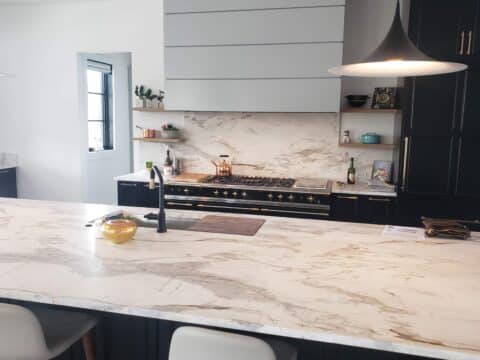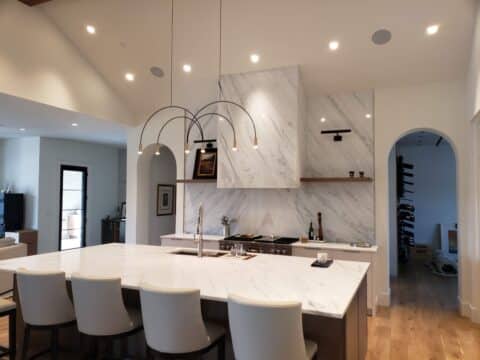How to Care for Marble Countertops
Marble countertops are luxurious and will instantly give your kitchen, bathroom or other living space an upscale look. It’s no surprise that it has become one of the top countertop materials on the market. Marble brings significant value to your home and is highly sought out by home buyers. It is perfect in traditional or contemporary design style homes and commercial projects.
Marble’s timeless beauty makes it perfect for your next project. With the appropriate care and maintenance, it can be used for your kitchen countertops or island, bathroom vanity, fireplace surround, and other configurations. Before deciding on marble, you should understand that it requires special treatment in order to maintain its natural beauty and longevity.
Types of Marble
Just like other natural stones, marble slabs come in an array of colors and vary in veining and patterns. It mostly consists of minerals such as calcite, limestone and dolomite. The composition of each slab may not only influence its coloring and veining, but how durable the slab is as well.
Since marble is a natural stone, its mineral composition depends on its origin and formation process. So, not all marbles are the same. Some marbles are considered softer than others and require extra care and attention. They may be more susceptible to staining, etching, scratches, or cracks. Each slab varies, and your fabricator should be able to examine your slab to determine the best space and use for it depending on your expectations.
Popular marbles include:
- Calacatta Marble: An elegant and high-end marble from Italy. A white stone with pronounced veining ranging from gray to gold. Stunning used as a kitchen backsplash, all-marble bathroom or accent wall.
- Carrara White Marble: Carrara White is a widely recognized marble from Italy. It is a white stone with fine dark gray veining throughout. This is one of the most popular marbles and looks beautiful in polished or honed finishes. It can be used as a kitchen countertop, bathroom vanity or butler’s pantry.
- Monte Bianco Marble: This stone is also quarried from Italy and is one of the most highly regarded stones that has been used for centuries in home and construction projects. This marble is typically white or light gray with subtle gray swirls and veining. This stone is ideal for kitchen countertops, accent walls, or backsplash designs.
Dolomite (Marble)

Odyssey white dolomite marble
Dolomite is one of the harder minerals found in marble slabs. Marbles with a higher composition of dolomite are referred to as Dolomite. This type of marble is considered to be stronger, slightly less porous and more durable than other types of marble. If you’re looking for a more resilient marble, dolomite may be the best option.
Dolomite possesses similar colors, veining and patterns as other marbles. It ranges in colors from shades of white, brown and gray. Each slab varies and has specific characteristics.
Some popular dolomites include:
- Odyssey White Dolomite: One of the most unique and stunning marbles. It is primarily white with gray and black veining and delicate patterns. Some slabs have dark and bold streaks while others have subtle blends of veining. It is beautiful when used for a fireplace surround, bathroom countertop, or kitchen island.
- Brown Fantasy Dolomite: This dolomite is unique because it consists of brown, gray and white hues. These colors are layered in waves and each slab tells a story. This stone originates from India and adds sophistication to any space. It is beautiful in kitchens or bathrooms for a stunning tub surround.
- Super White Dolomite: This is a dolomite derived from Brazil. It resembles the classic look of marble with white undertones and intricate gray veining. This is often used in luxurious projects because of its clean and elegant appearance. This is a popular marble suitable for a wide range of applications such as kitchen countertops and islands as well as accent walls and fireplace surrounds.
Characteristics of Marble
Marble countertops are most known for their breathtaking beauty and aesthetic appeal. Most marble slabs are primarily white with gray veining and patterns throughout. However, they can range from neutral hues such as gray or beige to even green or black. Each slab is different, and any variations or imperfections are a part of marble’s natural beauty and should be expected. This only contributes to the uniqueness of your marble countertop.
Marble is a naturally cool surface to the touch. It does not absorb heat like some other stones such as granite. Although not entirely heat resistant, its tolerance to heat makes marble a great choice for kitchen or bathroom countertops.
Marble countertops are made of porous minerals that are susceptible to absorbing liquids and moisture, which could stain or etch the surface. Compared to other stones such as granite or quartz, marble is much softer and more porous. Due to its porosity, it may be better suited to low traffic areas with little or light use. This can, however, depend on the amount of daily and long-term care you are willing to put in. Despite the extra maintenance required with marble due to its inherent properties, many homeowners find themselves extremely pleased with their marble countertop.
Daily Maintenance
 The amount of maintenance required for your marble countertops is subject to its place and use. Marble used in kitchens and bathrooms may require daily cleaning. In general, your marble countertop can be wiped clean using a non-abrasive cloth and a neutral pH cleaner or soap mixed with lukewarm water. Routine care is essential to keep your stone as beautiful as the day it was installed.
The amount of maintenance required for your marble countertops is subject to its place and use. Marble used in kitchens and bathrooms may require daily cleaning. In general, your marble countertop can be wiped clean using a non-abrasive cloth and a neutral pH cleaner or soap mixed with lukewarm water. Routine care is essential to keep your stone as beautiful as the day it was installed.
Spill Cleanup
Spills can become harmful to your marble countertop surface quickly if left unattended. Marble is naturally porous, so liquids and bacteria can seep through the surface, causing it to stain or etch. Since marbles are typically white, any sort of staining can be easily seen and obscure your marble’s beauty. Spills should be immediately wiped to avoid long-term damage. When it comes to spill cleanup, there are certain things that you should avoid such as:
- Acidic substances: Acidic substances such as citrus, wine and vinegar can be especially harmful to your marble surface because they can quickly cause staining or etching that is permanent. If these come in contact with your marble countertop, they should be promptly removed.
- Oil and Grease: Oil, grease or other residue may be left on a hot pot or pan and can bake into the surface of the stone. Make sure objects are wiped clean before setting them on your marble. If grease or oil is on your countertop, blot them; do not wipe them because they can spread.
- Still Water: Standing or still water will eventually absorb into your marble, causing staining or etching, especially by a sink. Water spills should be cleaned as they occur with an absorbent and non-abrasive cloth.
- Abrasive cleaning: Any type of abrasive cloth, sponge or extreme rubbing can render scratches on the surface. Use a soft microfiber cloth and gently wipe or blot the marble countertop.
Avoid Harsh Cleaners
Avoid acidic cleaners and harsh chemicals. Cleaners with vinegar or lemon juice should never be used because the pH and acid in them can breach the surface. These can cause staining, etching or even discolor your marble. In addition, do not use scouring powders or creams as these products contain abrasives.
Prevent Scratches or Damage
Marble is a softer stone compared to other stone materials. For this reason, it is susceptible to scratches. You should avoid cutting or chopping on the surface, and any tools or sharp objects that can result in a scratch or mark. It is highly suggested to use cutting boards or a chopping block.
In addition, heat or grease from hot pots and pans can ruin your countertop surface. Even though marble is tolerant to heat, it can ruin or wear away the sealant. Using coasters and trivets as a barrier between any object and your marble stone will keep blemishes or scratches from occurring.
Polishing Your Marble
Marble can be polished daily with a stone-intended and manufacturer-approved polisher. This will restore the shine and luster of your stone and remove any dust or debris. If dust accumulates, it can scratch your marble’s surface. Routinely polishing your marble will enhance its natural beauty.
Long-term Maintenance
 Long-term maintenance and proper care are essential to maintain your marble’s appearance and durability. Regular sealings and professional restoration as needed will prolong your marble’s lifespan. Understanding the inherent properties of marble and the best ways to care for it over time will help you preserve your marble countertops.
Long-term maintenance and proper care are essential to maintain your marble’s appearance and durability. Regular sealings and professional restoration as needed will prolong your marble’s lifespan. Understanding the inherent properties of marble and the best ways to care for it over time will help you preserve your marble countertops.
Sealing
A sealant acts as a barricade from liquids and bacteria by penetrating the surface to fill any pores, crevices or fissures. It is essential to apply a high-end, marble-specific sealant to avoid staining or etching caused by liquids absorbing into the surface. Typically, natural stones are given an initial or base sealant as part of installation. After installation, porous stones such as marble typically require 2-3 coats of a porous-plus marble sealer. For best results, it should be reapplied every 24 hours so that the sealer can cure properly. Sealers can be bought from your fabricator or at retail stores such as Hard Rock or Granquartz.
Professional Restoration
Over time and with wear and tear, your marble countertop may require professional restoration. It’s important to consult a stone professional or restoration expert if you come across deep scratches, stubborn stains, or other significant issues. Scratches, chips or cracks may appear, and they may or may not be repairable depending on the severity. In most cases, small chips and cracks can be filled with an epoxy or adhesive similar to the color of your marble countertop. Scratches may be carefully buffed or polished using special techniques to restore marble to its original luster.
Properly addressing any significant issues or blemishes in your stone requires care and patience. Professionals have many tips and tricks when it comes to restoring your marble to its best appearance.
Maintenance Schedule
Creating a maintenance schedule for your marble countertop will maintain its longevity and performance. This includes cleaning, resealing and periodic professional maintenance. A suggested schedule for your marble countertop may depend on its use; however, it should generally be resealed once or twice a year. In addition, polishing your marble on a daily to weekly basis will help keep its shine. Taking these measures will ensure your marble will be in its most pristine condition and last for years to come.
Granite and Marble Designs for Your Marble Countertop Project
Granite and Marble Designs has worked with thousands of marble slabs, and we know the intricacy and care they require. We specialize in the design, craftsmanship, and installation of all marble countertops and applications for residential and commercial projects. Our skills and experience rank us as one of Denver’s top fabricators for marble countertops.
We offer many marble slabs in our warehouse and work with all of the best suppliers to help you find the exact slab of marble that suits your project and expectations.
Request a free quote for your marble countertops and get started on your next project.
